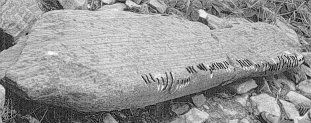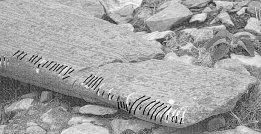According to Hitchcock, PRIA 6, 1856, 439, this stone was found in the "circular stone enclosure" named Cathair na g-cat in Oct. 1855 by one Rev. J. Goodman, "covered with rubbish". It was erected by him and "half a dozen men .. on the top of the Cathair" at the same date (according to Macalister, CIIC, this was done `"for protection"'). On 2.9.1856 it was visited by R. Hitchcock who made a rubbing and "a rough, but accurate, diagram copy of the inscription"; Hitchcock "was not able to make a sketch of the whole monument", however (PRIA 6, 1856, 439). According to Macalister, CIIC, it was smashed into three pieces by a man who was searching for a treasure inside it in the 1890s; the third piece containing the end of the inscription was no longer present when the site was visited by Macalister. At this time, the stone was still standing upright (Epig. 1, 53). According to Sheehy, Dingle 22, the third piece was later used as a lintel. When visited in 1981, the inscription had been redrawn for better readability by somebody using chalk.
The stone was mentioned as the "Cahernagat stone" in Brash, JRSAI 10, 1869, 258, as an example for an inscription containing the element RETT; cf. {106}.
Published illustrations:
- Hitchcock, PRIA 6, 1856, 440 (draft of stone standing upright [sketched by whom?]);
- Macalister, CIIC 1, 166 (sketch of inscription only,"Ferguson's cast" being used for suppletion of the missing letters).
TOGITTACCMAQESAGARETTOS
Togittac = Toictheach (AD 808), Toicthuich (AD 895, both from the Ann. 4 Masters); cp. also Mart.Don. p. 5, 279; Gaul. Tocco (Mom. 130), Toccae, Togirix (Orel. 162, 326). Instead of the usual Maqi we have Maqe here. Rettos with "prefix Saga" supports the reading "Sagi Dari" of the inscription at Burnfort {56} as proposed by M. Horgan.
TOGITTACCMAQISAGARETTOS
As maqi is a gen. and not "in agreement" with nom. Togittacc, this must be understood as "Togittaccus Sacerdos Filii"; "a highly Christian and doctrinal meaning."
(i): TOGITTACC
(ii): MAQISAGARET
This has to be completed to Togittacc maqi Sagarettos. Togittacc (for Togittacci by "agglutinating construction") = Toictheg in Clonmacnoise {774: CIIC 2, 61}, Toicthech in mss. According to Stokes, Celt.Decl. 150, the connection between Sagarettos and Sagart `a priest' "implies a want of philological perspective"; cp., however, Netta-Sagru {426}, Sagr-amni {449?} {489?} or Branittos {29}.
TOGITTACC MAQI SAGARETTOS
TOGITTACC MAQI SAGARETTOS
The stone "has recently [!] been broken in two".
TOGITTACC MAQI SAAGARETTUS
[Sic!]
TOGITTACC MAQI SAGARETTOS
The stone was smashed into "several" ("е№й&127;жгф&127;ж") pieces. The final -I of TOGITTAC was apocopated, because it was in an unaccented syllable ("ў йлммя&127;й№"!). -I- represents a reduced vowel (shewa) in the neighbourhood of a palatalized consonant. The inscription dates from the period immediately before syncope, 1st half of the 6th century. In the second name, -S was preserved, which should have disappeared between the 5th and 6th centuries; also -GR- is preserved. As G should have got lost in the 1st half of the 6th cent., we arrive at the beginning of the 6th cent.
Reading Gippert (1981):
Sinister angle,  "left to
"left to  right":
right":
TOGITTACC [MA]QI (S)AGAR(E)[
нгредннвомомж[пв]онедж(кй)врвтсе(г)[
лллввппвввввлллжлллвллллжлллл[пв]лллллввввв(зззз)вппвпппппввв(в)[
An accurate reading was made difficult by the chalk strokes that had been used by somebody to "enhance" the inscription. At the  end, a further piece seems to have broken away; not traces of what was read as -TTOS before could be found. A re-reading is necessary in any case.
end, a further piece seems to have broken away; not traces of what was read as -TTOS before could be found. A re-reading is necessary in any case.
Additional literature:
- Stokes, Wh., Celt. Decl., 150.
Last changes of this record: 29.04.97
Copyright Jost Gippert, Frankfurt a/M 1996. No parts of this document may be republished in any form without prior permission by the copyright holder.  "left to
"left to  right":
right": end, a further piece seems to have broken away; not traces of what was read as -TTOS before could be found. A re-reading is necessary in any case.
end, a further piece seems to have broken away; not traces of what was read as -TTOS before could be found. A re-reading is necessary in any case.

